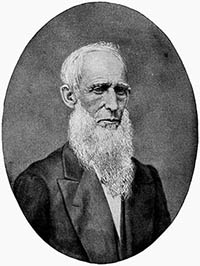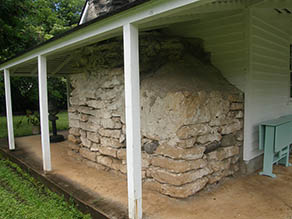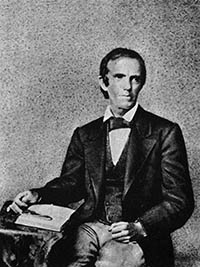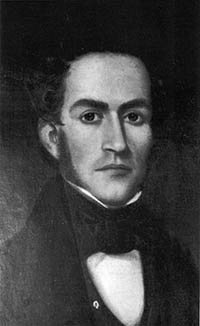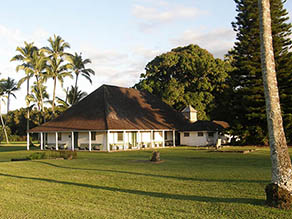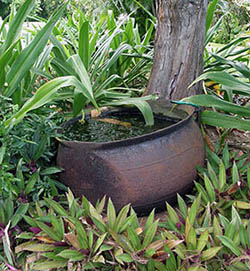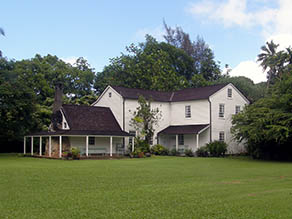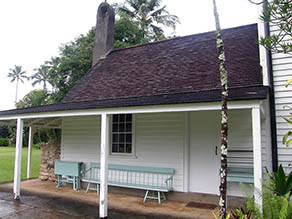 |
 |
 |
 |
||||||
|
|
|
|
|
|
|
|
|
|
 |
|
 |
|||||||
 |
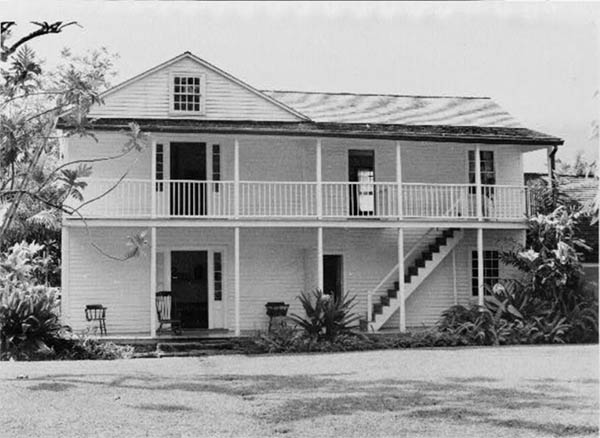
|
 |
|
 |
"There were no missionary stations in Hā‘ena, it was still a very remote area" Chipper explains. "Hanalei was an early missionary station, and I'm sure that the missionaries made an effort to come out here periodically. It wasn't that remote—it was an easy canoe ride from Hanalei. And there were missionary stations on the other side of the island, at Waimea, where the first missionary station was established. But there is no direct knowledge of the impact of missionaries on the people here in Hā‘ena."
"The first missionaries’ ship left in Boston 1819 and came around the Horn. Those were the pioneer missionaries, and they came around the horn later in 1820. With them they brought printing presses, doctors, teachers and priests. They wanted to teach the Hawaiian people about their bible, and to teach them to read. They gave them an alphabet so they could read their own language. Hawai‘i was the most literate nation in the world in the late 1800’s because the missionaries were teaching everyone to read and write their own language. Before that, it was all in chants and song, oli. "That first ship brought the King Kaumuali‘i’s son back to Kaua‘i. Kaumuali‘i was so happy, he let the missionaries build a station right there in Waimea, which was the first station on Kaua‘i. Another station grew in Koloa, Kaua‘i and then the last station was Wai‘oli Mission House, which is this one right here." "The mission station was established in 1834 by William Patterson Alexander, and construction of the home began in 1835 and was completed in 1837. The governor Kaikuiwa had lent William Patterson Alexander, his wife and his young child, his double-hulled canoe. He came around the Pali Coast at night, an eight-hour canoe ride, and landed at Wai‘oli where there were 70 Hawaiians waiting for them. "They had a pole-and-thatch hut built for the Alexanders already, and it was only a half a mile from the beach, next to where the green church is today. He lived there, the house blew down, he built it back up and then it burned down. So in order for the mission to last, they had to build a permanent dwelling. They considered a coral-sandstone structure such as Kawaiaha‘o church in Honolulu, but decided it was too labor intensive. "The American Board of Commissioners for Foreign Missions [ABCFM] allowed William Patterson Alexander $2,000 to build this frame house, this mission station. He started with cutting the blocks of the chimney out of the reef at Hanalei. They plastered them together with coral they had cooked down in the kiln. He laid up the chimney and foundation, finding out how hard that was—breaking axes. "He decided to build the rest out of native wood, which he got at the base of the mountains at Wai‘oli Valley. The wood was pit sawed, drug down and assembled. The home took two years to build. The glass, the hardware and some of the beams in the roof came around the Horn from Boston, and the zinc sheets for the roof were soldered together. It took two years to build at as cost of $2,000. "The home was occupied by Alexander then for the next five years. He acquired asthma because it’s so wet and moist back at Wai‘oli. He requested a transfer to Maui where he could keep working, and was replaced by Rev. Rowel and his wife Mavlina. Rev. Rowell lived in Waimea side of Kaua‘i, and he came out and aided at the Wai‘oli station for three years with his wife. "When he returned to Waimea, he was replaced by Abner and Lucy Wilcox, who were being transferred from O‘ahu to Wai‘oli to aid as teachers (establishing a school was a prerequisite for Congregationalist mission stations, and this station had three). They were the last missionaries to live in this home. They had four sons when they arrived. The nails in the zinc sheeting were starting to rust and the roof was already starting to leak, so Abner replaced them with shingles on to keep the house occupied. In the summers of 1840 and 1841, he added on a dining room and a pantry, connecting the previously separate cook house, combing it into a larger, single structure with the main house. "The mission hall pre-dates the church—1834. It was originally an open-sided, poll-and-thatch structure, 94 by 102 feet. That was torn down and restored into a Sunday School building and meeting hall when the Green Church was built. So it’s the same area where Alexander lived. It was a thatched house, but it had glass windows. The hall was reconstructed in the early 20’s, when the granddaughters restored everything. "There was a church building back then as well, and the Meeting Hall. That was what they used. At Wednesday prayer groups there would be 500 to 600 Hawaiians, and on Sundays there would be 800 to 1,000. Everyone came to meeting here. And the missionaries also went village to village. "Abner was the first truant officer, so when the kids didn’t show up for school, he knew right where they were. He’d go down on the beach and corral them back. "Dr. Smith was here inoculating people for smallpox. Smallpox was pretty rampant. And almost all the Hawaiians got it. And even some of the missionaries got it too. But the inoculation really helped. Dr. Smith lived in Kōloa and he came out here and inoculated people, and helped with births. Usually it was just the midwife and the husband because it was a two-day horseback ride out here from the other side. "And as far as education goes, they taught them to read and write. And we’ve got geography books, we’ve got algebra books upstairs in the house that were printed on the original press in Honolulu. So there is a lot of histories. "The missionaries taught the Hawaiians how to sew. They knew how to weave but they’d never seen needles and thread before, so the missionaries taught them quilting, they taught them buttons and collars, and they taught them dresses. "The mission station was a working farm. They had pens for goats, and they had a cow, and they had chickens and turkeys and they had fresh fruit. They had fresh water. The water was poured through coral to filter it. And they got it from the stream on the other side of the school. "They made their own candles and they made them out of beef tallow. They had to cook down the bones and boil it and skin the top of that stuff and then pour it into the mold, and it was really gross smelling. But it’s what they had. Earlier they used kukui nut oil and when they pressed it, they sold some of it also, for money to repair the meeting hall and the schools as necessary. They had whale oil too. When the whalers came in, they could trade with them too. "They lived through a lot of trials and tribulations. It was always raining, always raining. Abner was sick the whole time, he was coughing the whole time he got here. He was sickly, he didn’t like it; he thought he was being punished. This is the furthest most outpost of all the stations, the western-most place you could go in the islands. Lucy sold eggs, anything to make extra money when the ships came in. June, July, and August when the surf is flat in Hanelei Bay, the ships would come in and, and once they acquired a cow, she churned butter to sell for extra money, because they were only paid $400 a year and they got fifty or sixty dollars extra for each child. "They’d go shopping every year to O‘ahu. They had an annual meeting. The missionaries made sure everyone was on the same page, so they all went to O‘ahu every year and swapped notes. They also filled out their grocery lists—that’s how they got paid, they got to shop at the depository, where the missionary barrels came around the Horn. It was like the Salvation Army: the stuff that people back East didn’t want. They sent it in missionary barrels to the Sandwich Islands, and they went to O‘ahu where it was separated by Levi Chamberlain. He would distribute all the goods to the different missionaries. "There were thirteen stations around the Sandwich Islands back then. So they all went to O‘ahu, they all went shopping. Saddles, coffee, nails—anything they couldn’t find out here and this was the stuff. And the only reason Lucy didn’t go because she got seasick so bad, so Abner had to go to the meetings and come back. "Getting mail took almost a year and a half to get around the Horn, and sometimes it wouldn’t make it. So if you wrote a letter, they wouldn’t get it for a year and then vice-versa too. As far as knick-knacks, they sent shells and sugar and little knick-knacks, lava hair—Pele hair they’d call it—and they’d sent that back in little boxes back East to their friends and relatives. In turn receiving trinkets, toys—things from back east, candy—sugar candy, things like that for the kids. Small little trinket toys. "The Hawaiians wanted books and they would bring paddles, they’d bring taro, they’d bring anything they could make. Arrowroot, cordage from hau, just to trade for books—books were in short supply. They’d put a book down in the middle of six or seven kids, and a lot of the kids learned to read upside down and backwards. There’s even photographs of people sitting in Honolulu reading the newspaper upside down in Hawaiian. So books were a commodity. The Hawaiians here had never seen a knife and fork before so they were at the windows watching the missionaries eat. "In 1869, the older sons of Abner and Lucy gathered funds to purchase tickets for them to go back East to see family. The Transcontinental Railroad had just been completed, so instead of going all the way back around the Horn, they took the youngest son and went to Oroville, California and dropped him off with the oldest boy Charles, who had been working in mining with Lucy’s brother. They then went to Sacramento, boarded the transcontinental train to go back East. But they had acquired a Malaria-type fever, from which they both passed away within eleven days of each other in Connecticut. They never returned back to Wai‘oli, so the house stayed empty for 45 years. "After the Wilcoxes left, the local teachers took over. This was a select school, which was located in back of the bell tower, behind the meeting hall. Abner taught the boys and Lucy taught the girls, and they taught them to be teachers and community leaders themselves. So the brightest kids from Ni‘ihau and Kaua‘i would come out here and board, and there would be four hours in the field and six hours in the classroom. They had a common school for the kids who just wanted to learn the ABC’s and read Hawaiian, and they had a theology school too where some kids wanted to learn about the Bible. So when they left, they had somebody in charge of the schooling and of the preaching and everything. "No one stole anything while the house sat abandoned, just the termites came in and made themselves at home. The house was to be burned down in 1919 by their fourth son, Albert Wilcox. The granddaughters, Miss Mabel Wilcox, Miss Elsie Wilcox, and their sister Mrs. Etta Wilcox Sloggett, wanted to restore the house in honor of their grandparent’s hard work. "Uncle Albert was determined to burn it down but he passed away in 1919, so the granddaughters bought the property from his widower, Emma Kauikeolani Napoleon Mahelona Wilcox. She gave her blessings that the sisters pursue their intent to make it a historical home. So the sisters started restoring the house. Around that time, the Green Church was built by three of the boys that had stayed, Sam, George and Albert, in 1912. "This house is actually a time capsule. And so when you go through the house, it’s like the Wilcox’s will be back in 20 minutes. The granddaughters, when they restored it, left everything as is. As for the stuff that the termites eaten. in 1919-1920 they went back East, to primarily New York and Boston, for antique-hunting and bought furniture of that time period to put in the house, to fill the house up and make it very Feng Shui. But there are still a lot of original Wilcox pieces here. "They found letters and documents up in the attic when they opened up the house to restore it. And when they went back East antique hunting, they found more letters from Abner and Lucy writing to the relatives—32 years of letters. These they condensed into a book—there’s about 450 pages—and that’s where we get our information. Because the missionaries had to write down everything almost every day to report to the Board, and their cousins, and tell them what a great job they were doing out here with the Polynesians."
|
 |
||
 |
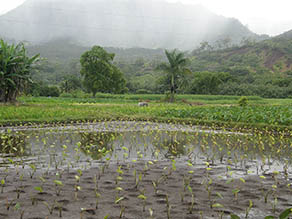
|
|
 |
 |
Let Roger take you on a tour of the house, room by room:
|
 |
||||||||||||
 |
|
 |
||||||||||||

|
|
||||
| Copyright 2018 Pacific Worlds & Associates • Usage Policy • Webmaster |
||||
